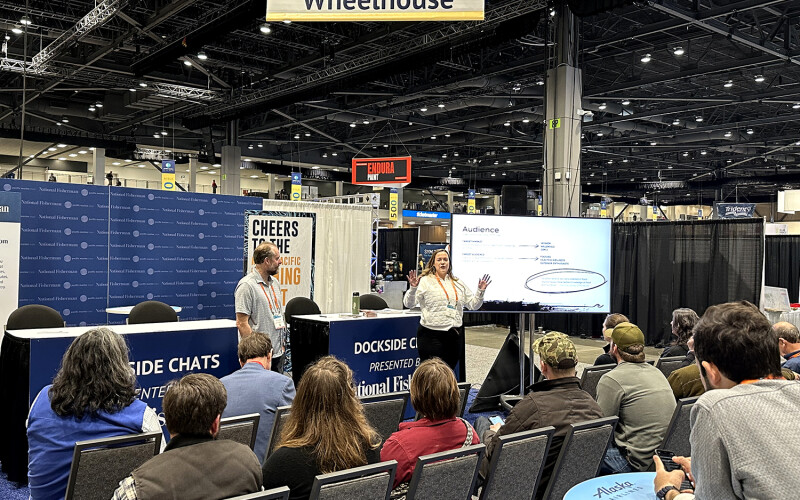The covid-19 pandemic forced many fishermen – already independent businessmen – into an entirely new line of demanding work: selling their catch directly to the public.
That marketing can start with a first step of establishing a “brand voice,” said Bri Dwyer, an Alaska fisherman, photographer, and owner of PGTSND Productions, a media agency in Edmonds, Wash., that works with fishermen.
That voice helps customers arrive at “the reason why they’re going to come back and buy from you,” Dwyer said at “Money for Fishing,” a seminar she hosted at Pacific Marine Expo Wednesday with Matt Alward, president of the United Fishermen of Alaska and a 2023 National Fisherman Highliner.
Computer maker Apple followed a model of setting out “mission, vision, values” for its brand, said Dwyer. Fishermen can follow that formula for their business with thinking about key customers.
A primary “target market” for direct-sales seafood includes women, millennials, and Generation Z buyers, said Dwyer. Women “tend to be more invested in food and health,” while marketers see that millennials and Gen Z age groups are the most influential worldwide in seafood consumer sales, she said.
Good target audiences are consumers interested in food culture (popularly “foodies”), outdoor activities, and health. They can be reached by multiple routes - online, in person such as at farmers’ markets, or some combination, said Dwyer.
Dwyer urged aspiring direct-sales fishermen to invest in creating their own websites. “Facebook is not a website,” she stressed. An established website gives consumers assurance of where to find their products and producers, she said.
But social media is a valuable tool for marketing. In her guidelines, Dwyer recommends that fishermen establish a winning personality and presence by being “authentic, entertaining, educational, stir emotion and offer some value for free.”
As the old saying goes, you have to spend money to make money. An array of federal, state, and nonprofit grant possibilities are out there that can help get small fishing businesses geared up for the task.
One source is the federal Saltonstall-Kennedy Act, a program first established in the 1950s to provide financial support for the promotion and development of U.S. seafood. Alward is chair of the American Fisheries Advisory Committee (AFAC) that oversees the competitive grant program funded by Saltonstall-Kennedy.
The committee was reorganized just last year for the first time since 1976, after years when the National Oceanic and Atmospheric Administration itself chose among all seafood grant applicants, said Alward. So the process again has fishing industry representatives involved in weighing applications, he said.
Federal grants under the S-K program and many others, including an array offered through the U.S. Department of Agriculture, can cover a range of business expenses, Dwyer and Alward said.
Just be aware, Dwyer said, that “federal grants are a beast. You really are curating a business plan.”
“You really want to write to the grant reviewers,” who pay meticulous attention to applicants’ information and proposed uses, said Alward.
“You want to put into those applications that you have the ability to handle the money,” said Dwyer. That includes describing accountant services, payroll taxes, and overhead costs that can be among the expenses potentially covered by grants.







